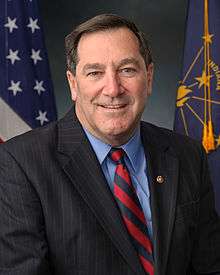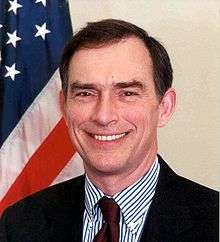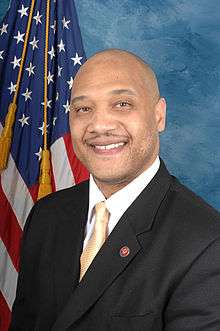Indiana Democratic Party
Indiana Democratic Party | |
|---|---|
 | |
| Chairperson | John Zody |
| Senate leader | Timothy Lanane |
| House leader | Scott Pelath |
| Founded | 1816 |
| Headquarters | Indianapolis, IN |
| Ideology |
Modern Liberalism Progressivism Fiscal conservatism |
| National affiliation | Democratic Party |
| Colors | Blue |
| Seats in the Upper House |
9 / 50 |
| Seats in the Lower House |
29 / 100 |
| Website | |
| www.indems.org | |
The Democratic Party of Indiana is the affiliate of the Democratic Party in the state of Indiana.
The Indiana Democratic Party holds one of the two US Senate seats and two of Indiana's nine Congressional seats. The party Chairman is John Zody.
History and important figures
Statehood era
The Indiana Democratic Party has its roots in the work of Jonathan Jennings, Democratic-Republican and first governor of the newly formed state of Indiana in 1816. Jennings pushed hard for statehood, and is attributed as an intellectual father of the Indiana Democratic Party. He pushed for a statewide school system and a stable state bank.[1]

Civil War era
Indiana political parties in the 19th century were extremely divided culturally. Indiana, more than any other Midwestern state, received an influx of southern farmers who didn't mix well with northern manufacturers and businessmen. Patronage was given out regularly as Democratic and Whig (and eventually Republican) politicians fought for control of state government.[2] Whigs predominantly controlled the state legislature, while Democrats predominantly controlled the governorship. Turbulent elections and heated Democratic passion ended up persuading 50 Whig legislators to switch parties by 1852. Even though William Henry Harrison, a Whig and one of the first governors of the Indiana territory, ran for president in 1840, Democrats like Joseph Chapman were very critical of him and his supporters.[1]
The first Indiana Democratic Party meeting was held in 1848, and at the time was called the "Indiana State Central Committee of the Democratic Party". Only seven men were in attendance. Thomas Hendricks, nephew of the third governor of Indiana, became the first post-war Democrat to be elected governor in a Northern state. His popular bipartisan leadership would eventually lead him to be President Grover Cleveland's first vice president from 1885 to 1889.[1]
20th century
As the city of Indianapolis grew into a massive urban area, Democrats began to continuously represent the city in the state legislature. Thomas Taggart, the mayor of Indianapolis from 1895–1901, became the first Hoosier to become chairman of the Democratic National Committee. In 1913, Thomas Marshall, Governor of Indiana, became yet another Democratic Hoosier to be a vice president (under Woodrow Wilson). Marshall is perhaps best known for his humorous quote as vice president, said on the Senate floor: "What this country needs is a really good five-cent cigar."

Years later, World War II veteran Frank McKinney became a delegate in the 1948 Democratic Convention, and later became the second Hoosier to be Chairman of the Democratic National Committee in 1951.
In the 1980s, Evan Bayh became a popular figure within the Indiana Democratic Party as well as the state of Indiana. A young governor elected in 1988, Bayh was later elected to the U.S. Senate in 1998. Bayh's two terms as governor, along with his lieutenant governor Frank O'Bannon's own gubernatorial years, resulted in a budget surplus, tax cuts and increased funding for education and health insurance for the poor.[1] Long considered a moderate, Bayh was rumored to be a top pick for Barack Obama's vice presidential nominee in 2008, but the spot ended up going to Delaware Senator Joe Biden. Bayh did not run for reelection in 2010.
2011 walk-out
In February 2011, 37 out of 40 House Democrats refused to show up to a legislative session in protest of a Republican right-to-work bill, which would allow workers to have the option of paying union dues.[3] With the Republicans in the majority, Democrats feared that what they consider to be a radical bill would be easily passed, and many of them relocated across the border in Urbana, Illinois. The move largely took a cue from Indiana's counterparts in Wisconsin, where Democratic lawmakers there hid out in Illinois in protest of a controversial public-sector union bill in the same month.
The Indiana Democratic caucus released a statement on the matter, saying that "By staying here, we will be giving the people of Indiana a chance to find out more about this radical agenda and speak out against it."[3] Republican Governor Mitch Daniels, who had previously urged Republican lawmakers not to pursue a right-to-work bill during that legislative session, stated his hope that Democrats would return to do their jobs. Daniels supported the bill, but not the political timing of it, as it would distract from other parts of his legislative agenda he wanted to focus on.
In early March 2011, Democrats faced a choice of either returning to the state, or paying a daily fine of $250. The Indiana Constitution allows such fines as a way of compelling missing lawmakers to return.[4] Such a tactic was employed as an alternative to sending state troopers after runaway legislators, which Governor Daniels declined to do. Lawmakers returned in six weeks, after they had been reassured that the right-to-work bill would not be on the legislative docket for that session.
Modern party structure and rules
The Democratic Party of Indiana is administered by several executive positions at the head of the state party committee. John Zody is the Committee Chair, Cordelia Lewis-Burks the Vice Chair, Vera Mileusnic the Secretary and Sherrianne Standley the treasurer.[5] There are 26 official rules for the Indiana Democratic Party, as of the current party rule charter, written in 2011.
Under Rule 1, party structure is defined as consisting of multiple layers of committees, including (in order from less to more localized) a state central committee, congressional district committees, county committees and precinct committees. Towns, cities, townships and wards may create their own committees as needed.[6]
The charter ensures gender equality, open access to party meetings by party members, and lays out eligibility requirements for membership in the state Democratic Party. The state central committee has ultimate authority over all of the rules as well as local committees. Three party members are elected as National Committeepersons for four-year terms to serve on the Democratic National Committee, along with the state chair and vice chair. The state chair calls for a state party convention biennially, where rules of the party are drafted and amended. Delegates are selected through a process to attend the convention.[6]
Elected Democrats in Indiana
Current Indiana Democrats in U.S. Congress:[7]
- U.S. Senate: Joe Donnelly
 Sen. Joe Donnelly
Sen. Joe Donnelly - District 1: Pete Visclosky
 Rep. Pete Visclosky
Rep. Pete Visclosky - District 7: André Carson
 Rep. André Carson
Rep. André Carson
State Executive Offices
- None
Current Indiana Democrats in State Senate:[8]
- District 1: Frank Mrvan
- District 2: Lonnie Randolph
- District 3: Earline Rodgers
- District 4: Karen Tallian
- District 8: Jim Arnold
- District 10: John Broden
- District 25: Tim Lanane (Senate leader)
- District 33: Greg Taylor
- District 34: Jean Breaux
- District 38: Tim Skinner
- District 40: Mark Stoops
- District 47: Richard Young
- District 48: Lindel Hume
Current Indiana Democrats in State Legislature:[9]
- District 1: Linda Lawson
- District 2: Earl Harris
- District 3: Charlie Brown
- District 6: B. Patrick Bauer
- District 7: David Niezgodski
- District 8: Ryan Dvorak
- District 9: Scott Pelath (Assembly leader)
- District 10: Chuck Moseley
- District 12: Mara Candelaria Reardon
- District 14: Vernon Smith
- District 19: Shelli VanDenburgh
- District 27: Sheila Klinker
- District 34: Sue Errington
- District 36: Terri Austin
- District 43: Clyde Kersey
- District 45: Bionca Gambill
- District 61: Matt Pierce
- District 66: Terry Goodin
- District 71: Steve Stemler
- District 77: Gail Riecken
- District 80: Phil GiaQuinta
- District 86: Ed Delaney
- District 87: Christina Hale
- District 92: Karlee Macer
- District 94: Cherrish Pryor
- District 95: John Bartlett
- District 96: Greg Porter
- District 97: Justin Moed
- District 98: Robin Shackleford
- District 99: Vanessa Summers
- District 100: Dan Forestal
Democratic presidential victories in Indiana
- 1828: Andrew Jackson
- 1832: Andrew Jackson
- 1844: James K. Polk
- 1848: Lewis Cass
- 1852: Franklin Pierce
- 1856: James Buchanan
- 1876: Samuel Tilden
- 1884: Grover Cleveland
- 1892: Grover Cleveland
- 1912: Woodrow Wilson
- 1932: Franklin D. Roosevelt
- 1936: Franklin D. Roosevelt
- 1964: Lyndon B. Johnson
- 2008: Barack Obama[10]
See also
- Category:Government of Indiana
- Political party strength in Indiana
References
- 1 2 3 4 http://www.indems.org/index.php/pages/history/
- ↑ http://library.cqpress.com/cqweekly/document.php?id=wr100404320&type=hitlist&num=55&
- 1 2 http://www.ibj.com/democratic-lawmakers-leave-indiana-block-labor-bill/PARAMS/article/25475
- ↑ http://ballotnews.org/2011/03/03/missing-indiana-democrats-to-be-fined-250-per-day-starting-monday/
- ↑ http://www.indems.org/index.php/pages/committee/
- 1 2 http://indems.3cdn.net/923e40d47e778c6f35_1ym6i6tin.pdf
- ↑ http://www.indems.org/index.php/pages/democratic_members_of_united_states_house_of_representatives
- ↑ http://www.in.gov/legislative/senate_democrats/listingbyname.htm
- ↑ http://indianahousedemocrats.org/members
- ↑ http://www.270towin.com/states/indiana